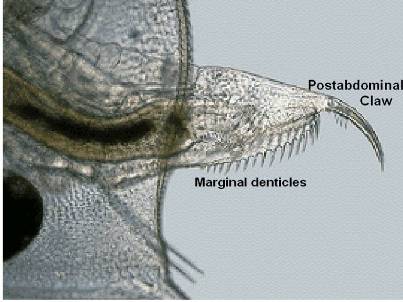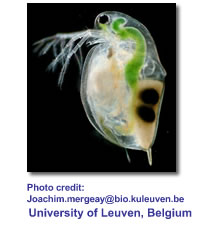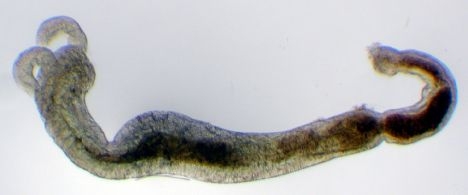Nutrition
D. pulex, as well as all other species of Daphnia, play an extremely important role in freshwater ecosystems. They help to keep water quality in control by feeding on both algae and bacteria. Daphnia also have a huge impact on phytoplankton populations and play a large role in the transfer of energy in the food web.
D. pulex's main source of nutrition comes from phytoplankton. Daphnia will feed on most types of algae they find available in their environment. In fact, merely all types of algae will support D. pulex short-term, but not all algae will support the organism long-term. Blue-green algae is one that this organism will not usually digest due to its cell wall being too tough, making it hard on the digestive system. Also, filamentous algae, which can be poor for the water flea's health, is another type of algae it tends to stay away from.

Although there has not been a great display of selectivity on the quality or size of food a Daphnia will take in, the organism still has the amazing ability to reject an unsuitable food (toxic, too large, etc) by a reverse kick of the postabdomen. The claws of the postabdomen connect with the food and then are used to flick it out of the chamber between the valves.
Above is the postabdominal claw used to clear
unwanted food and debris.
All genus of Daphnia, including D. pulex, acquire nutrients by means of filter feeding. They collect food particles from the water column. This is done by creating a constant current using their thoracic limbs through their carapace. Here, the organisms are able to filter out any unwanted food particles using their setae. Daphnia also have mandibles to break down and grind their food before it is digested.
In the photo above, you can clearly see the
green algae
this D. pulex has in its digestive tract.
D. pulex also has a digestive system that consists of both a mouth and an anus. The digestive system is actually very easily seen when looking at the organism through a microscope due to its transparent body. Daphnia have a gut, which consists of an esophagus, a midgut, and a hindgut. The midgut is lined with epithelium and has microvilli to increase surface area for absorption. Food travels from the midgut, to the hindgut, and out of the anus via peristaltic contractions as well as pressure from incoming food particles.
Above is actually the dissection of a gut from D. pulex.
In addition, Daphnia also have an open circulatory system consisting of a simple heart. Again, due to the transparent body, blood cells can often be seen under a microscope. Daphnia use their appendages to bring in oxygenated water from their environment. The transfer oxygen throughout the body is by means of hemolymph. If there is a lack of oxygen in the environment, the hemolymph will actually have a red color to it. The organism also contains the protein hemoglobin to support oxygen transport. Daphnia have an incredible heart rate of approximately 180 beats/minute. Keep in mind that humans only have a heart rate of approximately 75 beats/minute so overall that’s pretty darn fast!
Learn about D. pulex reproduction.
Go back home.

